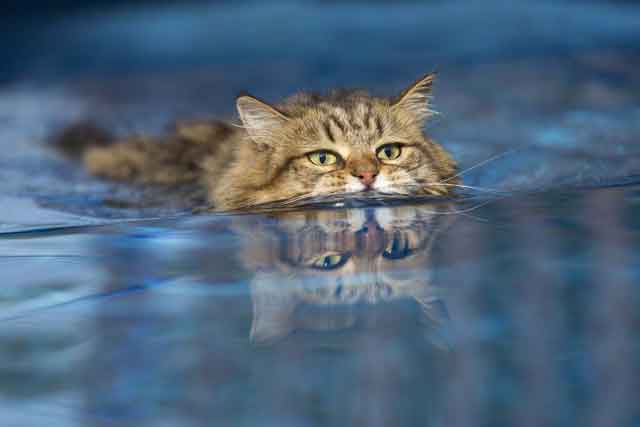Cats are usually kept in a cool house, so they are less likely to experience heatstroke, but the risk of heat stroke, acute hyperthermia, heatstroke... heatstroke in cats in the summer when the weather is too hot is not zero. Yes. So what should a cat with heatstroke do? The following article will guide you on how to handle heatstroke in cats.

Signs of a cat with heatstroke
Cat heat stroke is a condition that occurs in cats when they are left in the sun for too long or in direct sunlight. Like dogs, cats do not tolerate heat well and there are only 3 ways to regulate body temperature:
- Sweat glands in the soles of the feet.
- Panting to escape heat in the body, but the ability of the cat to regulate heat through the mouth is negligible.
- Instinct to find a shady place to avoid the heat.
When the body temperature rises too high, cats can begin to experience heat exhaustion and eventually heat stroke from heat stroke, which is a serious condition because it can cause rapid death in cats. Cats that are obese or flat-faced cats like Persians often develop hyperthermia more quickly.
Signs your cat has heat stroke:
- The cat is restless and frantically looking for a place to hide from the sun.
- Rapidly breath.
- Sweaty feet.
- Drooling.
- Licking the body continuously and intermittently due to the attempt to cool the body.
Signs that a cat has a severe heat stroke into heatstroke:
- The tongue is red and the gums may be bruised.
- Vomiting.
- Unsteadily staggered.
- Gastrointestinal temperature >40 degrees.
- There may be a nosebleed.
- When the temperature rises too high, the cat can collapse and fall into a coma.
How to handle when cats get heatstroke
How to lower body temperature for cats is similar to how to cool down dogs. However, care should be taken to handle heatstroke according to the cat's current condition.
New cats showing signs of heatstroke:
Step 1: Provide enough cool water for the cat to drink comfortably.
Step 2: Remove the cat from the hot environment immediately. If outdoors, put the cat in a shady place, at least with a canopy, awning, or near a water source and out of direct sunlight. If indoors, take the cat to a place with a fan to effectively cool the cat.
Cats showing signs of severe heat stroke:
Step 1: Move the cat to a cool, shaded place, preferably with a fan or air conditioner.
Step 2: Gradually reduce the cat's body temperature by finding the faucet, open the faucet to drain all the hot water in the faucet. When the water is cool, dip a towel to wet it and then cover the cat's body to completely cover the cat's body (from shoulder to tail) - or wrap it around the cat's body. Continue to let the cat lie still under the faucet and turn on the small faucet so that the water continuously flows down the towel and soaks into it.
Step 3: Lower body temperature immediately by filling the basin with water and submerging the cat in the water with its head raised out of the basin. If there is only a faucet or shower, you can let the cat lie under the faucet, using your hand to direct the water down the cat's entire body, especially the nape area behind the head and neck. When cooling your cat with a faucet, stroke the cat's fur in the opposite direction across the nape, neck, and back to help the water fully absorb into the skin to help the cat cool faster.
Note: Do not use very cold water or ice when handling a cat with heat stroke, as this will make the heat stroke worse.
Cats that are unconscious from heat:
If you feel that your cat is slow to react, even unresponsive to mild stimulation, unable to open its eyes and reflexes, then this is very dangerous because the cat may have developed internal problems. At this point, you need to do emergency cooling for the cat and take it to the vet for a checkup.
An emergency way to cool down is to put the cat in a basin of cool water without a towel in step 2, but this is also not recommended.
Cat's body temperature:
- From 37.5°C – below 39°C: Normal temperature.
- From 39 °C – 40°C: Abnormally high temperature to start inspection and treatment.
- From 40.5 °C: The cat's body temperature is too high and can be life-threatening, need to lower the temperature immediately or take urgent measures to lower the temperature.
- Cooling should be stopped when the cat's body temperature drops below 38 degrees Celsius.
Here is some information on how to handle it cats get heatstroke when it's hot that we want to share with you. Wish you have healthy and lovely cats. If you need to know more about other ways to take care of cats, contact http://vanchuyenchomeo.com/ for advice.